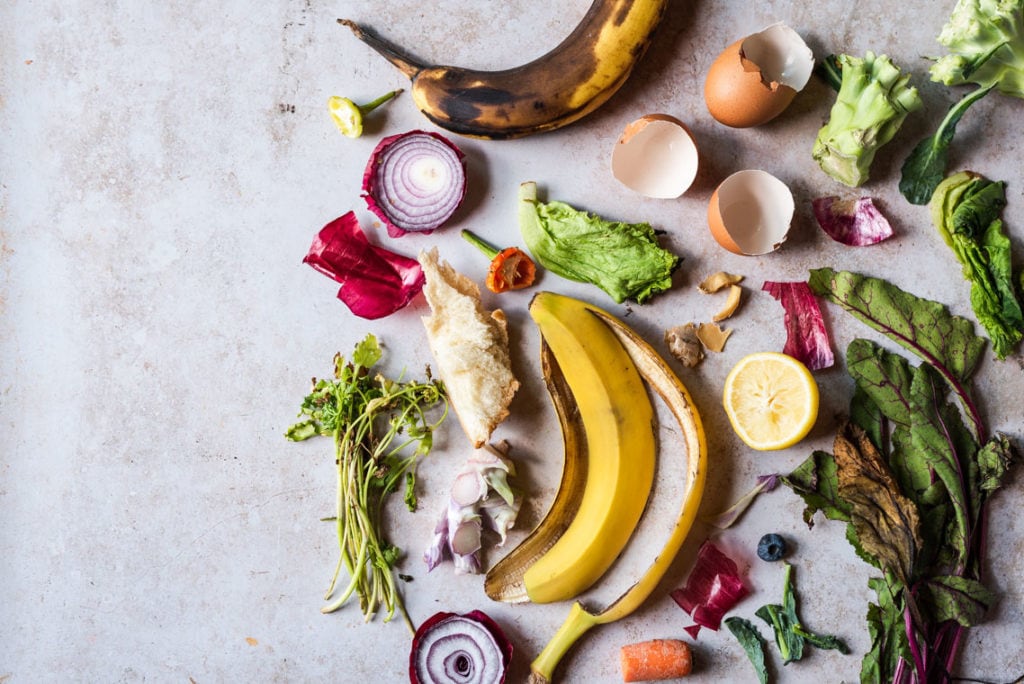A food waste audit sounds intimidating, but don’t let the name deter you. The process of looking at your food waste can be fun and eye-opening!
The problem with household food waste is that it’s very hard to measure - at least in each individual home. It’s so easy to overlook what goes in the trash - a little bit here and a little bit there. But it can really add up.
The data tells us that about 40% of all food produced is wasted and the average family of 4 throws out upwards of $2200 worth of food annually.
However, few of us actually know how much food we are wasting, why we waste it, or which foods are commonly going to waste in our homes.
That’s where the food waste audit comes into play. A food waste audit is similar to a journal where, for 1 week, you and your family/housemates keep track of everything that goes into the trash or compost. Afterwards, you have your own data and a powerful starting point for making simple changes to reduce how much food gets tossed in your house.

What is a food waste audit?
A food waste audit is simply recording all of the food you throw out.
We all throw away some food and for different reasons. By doing a food waste audit, you can better understand what food goes in the bin and start looking into why.
Some tossed foods are unavoidable like eggshells, banana peels and coffee grounds. Other foods can be avoided like limp lettuce, stale bread and leftovers.
An important note: this is not about blame or guilt. It’s like the saying goes - you can’t manage what you don’t measure. So if you want to reduce how much food gets thrown away in your house, you have to start with looking at what gets tossed and why.
Why do a food waste audit?
We have to figure out what we’re wasting and why. In order to change something, we have to first understand what we’re doing. Doing a food waste audit allows you to see how much food you’re wasting, what types of food you’re wasting and why they’re getting tossed.
Once you see what’s going in the trash (or compost), you can take steps to reduce what gets thrown away.
It’s the same with your money, if you don’t know how much you’re spending on groceries or going out to eat, how are you going to know how much to allot for a budget or how much you could save by spending a little less?
You have to know what you’re doing first.
That’s why we start with a food waste audit.
So we can see what goes in the trash and then start making adjustments to reduce what we toss. We don’t want our food waste to be out of sight and out of mind anymore.
For example, if you find you often throw away wilted spinach, you can brainstorm different ways to toss less, like buying it less often, figuring out more ways to use it or planning your spinach meals earlier in the week so it doesn’t go bad before you can use it.
How to conduct a food waste audit
There are many ways to do a food waste audit. Some include weighing, measuring or saving your food scraps.
But I like to keep things simple - no weighing or strict measuring involved.
All you have to do is jot down a few simple notes on a piece of paper (or you can download our FREE food waste audit workbook!) before you toss it.
There are five steps to a successful food waste audit.
1 - Pick your time frame.
You’ll want to choose a “typical week”, ideally a 7-day stretch. Normal events like soccer practice and PTA meetings are A-okay, but maybe skip the week of Thanksgiving. The idea here is to see what your waste looks like on a regular basis. It doesn’t have to be the perfect week, just commit.
2 - Prepare for data collection
You can use just a piece of paper or you can download our Food Waste Audit workbook which includes instructions and a tracking sheet. Like I said earlier, it’s hard to measure and make meaningful changes if we don’t see what we’re currently doing. Jotting down a few notes before tossing something will help you pick out patterns so you can make changes later on.
Especially if there’s more than just you in the house, I recommend printing your audit sheet and keeping it near your trash/compost with a pen for easy tracking.
I also recommend taking a picture of each item you toss, and at the end of the week compile them into a collage to give yourself a powerful visual of everything that gets thrown away.
There's a collage template in our Food Waste Audit workbook where you can input your images.
What should you track?
- The name of the food item. Feel free to keep it simple and just write the name such as chicken noodle soup or elaborate and list the main ingredients such as chicken noodle soup (chicken, noodles, carrots, celery, broth).
- The approximate amount. There’s no need to weigh everything. Estimations are okay. Using measurements like a cup or handful is often easier than 2 ounces. You can also do ½ in the case of a sandwich or head of broccoli.
- Where it was tossed. Were you at home, the office, perhaps traveling and at a hotel?
- The estimated cost (optional). If you bought a loaf of bread for $4 and you tossed half of it, you’d enter $2. This can be challenging for those who don’t do the shopping or aren’t overly concerned about what they spend on food. But, if you want to rack up that $2k in annual savings, estimating the dollar amount in your audit can be incredibly motivating. Just do the best you can with estimating the cost.
- The reason for tossing. This seems pretty self-explanatory, but it can actually take a bit of reflection to get to the core reason.
For example, for that bag of lettuce that got slimy - you could just enter “slimy”, but is that the real reason?
Perhaps you could enter “didn’t get to it”, but that’s not the real reason either. Think back to the reason you picked up the lettuce. Perhaps you bought it so you could bring a salad for lunch, but you ended up bringing leftovers instead or maybe you forgot to make the salad altogether.
It’s helpful to be honest (there’s no judgement here!) and remember, you’re doing this audit to help you see any patterns and learn what to do differently in the future.
Possible reasons we might toss things include:
- Bought too much
- Plans changed
- Didn’t store it properly
- Had to buy more than needed (i.e. you had to buy the whole head of cabbage)
- Didn’t like it
- Didn’t know how to cook
- Made too much
The last thing to track is...
Ideas to Reduce Waste. Get creative! What could you do differently to prevent or reduce this waste in the future? If you forgot it was in the fridge, you could write “put leftovers in glass containers instead of opaque ones so we can see what’s in it”.
3 - Explain the rules to everyone in the household.
Get the household involved! If anyone else in the house has the potential to throw food away, get them in on the action. Oftentimes kids will find this experiment fun and interesting.
4 - Start tracking!
Track anything (that was...) edible that gets tossed. Include things you would put into your compost, trash, down your garbage disposal or feed to your pets or animals.
Do your best to keep it up for a week. Remember, it’s not about perfection - commit to doing your best.
Things to keep in mind:
Track only edible foods. That is, what could have been eaten had it not been burned, molded or spoiled. Track the eggs (not the eggshells), the banana fruit (not the peel), the chicken meat (not the bones), the leftovers, half eaten apple (not the core), the half a glass of orange juice, the crumbs at the bottom of the chip bag, etc.
If something is moldy, slimy or rotten, it COUNTS! After all, it was edible food just a couple days ago. This is absolutely food waste and something we want to note.
Important: During your audit period, don’t worry about making any changes. In fact, it’s best to keep your normal routine - there will be plenty of opportunities to improve later.
Continue tracking for the entire tracking period that you set for yourself.
Visuals can be incredibly powerful so I’ve included a collage template in our Food Waste Audit workbook so you can create a powerful photo diary. When you make an entry on your tracking sheet, snap a quick photo of what you’re tossing. At the end of the week, compile all your photos into the collage template.
By the end of the week, you’ll have a powerful visual and data on what food waste looks like in your home.
5 - Evaluate and set some goals.
After your audit period, it’s time to take a closer look at your tracking worksheet and debrief.
Ideally, have the whole household together and start a conversation to debrief your food waste audit.
Are there similar entries? Do you often throw out the same food? Or do you find one of the main reasons for tossing is improper storage? What is the total amount wasted? Was there a day of the week that was more or less wasteful? Does it have to do with when you get groceries or your work schedule?
Once you identify any patterns or simply understand some of the reasons food gets tossed in your house, you can start brainstorming ideas for reducing that food waste.
It can be helpful to jot down as many ideas as possible, even ones that likely won’t work for you. Just write down anything and everything that comes to mind and then you can start experimenting.
How would you implement these changes? What would it look like to make these changes? Which changes feel realistic and easy to implement?
You can use the brainstorm worksheet in our Food Waste Audit workbook to help you brainstorm.
Write down between 1 and 3 goals that you and your household members can start implementing in your personal habits to reduce food waste in the next few weeks.
The Food Waste Audit workbook also has a spot for you to write down your goals to help keep you accountable.
Are you looking for more?
Here at The Crooked Carrot, we empower people to ditch diet culture, find peace with food and eat (and live!) in a way that aligns with their values of environmental sustainability.
If you want to incorporate more eco-friendly habits into your eating and are tired of dieting, but aren’t sure where to start, send us an email at hello(at)thecrookedcarrot(dot)com.
We can help you nourish yourself in a way that supports a healthy planet without dieting or restriction.
Don't forget to grab your Food Waste Audit Workbook!
Resources:
Bloom, American Wasteland, 187






Leave a Reply